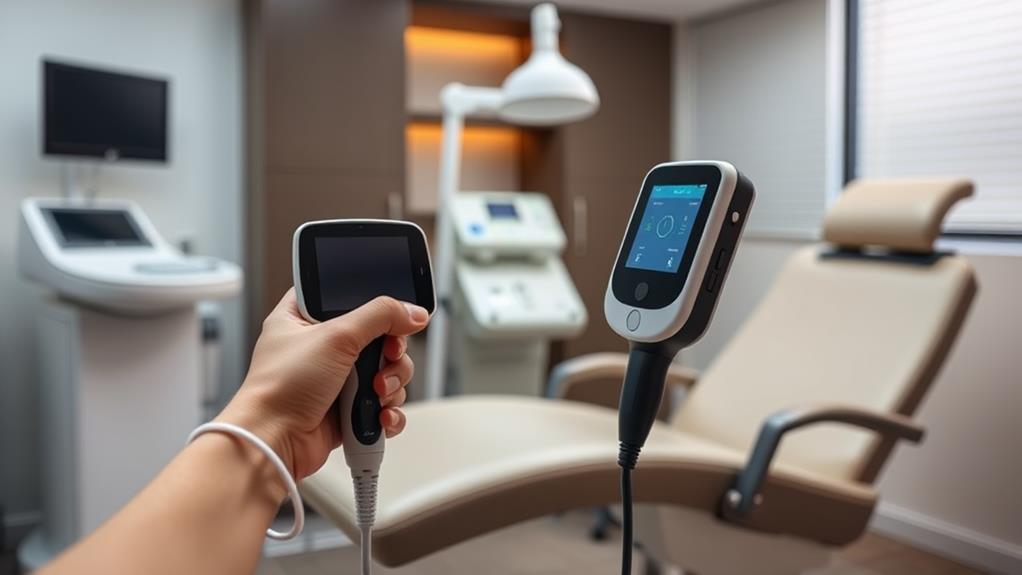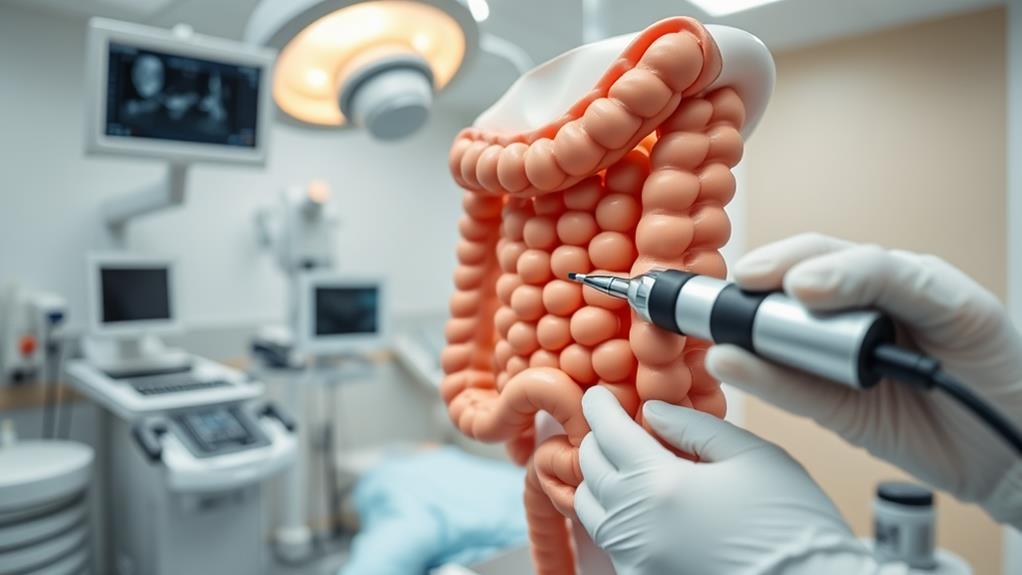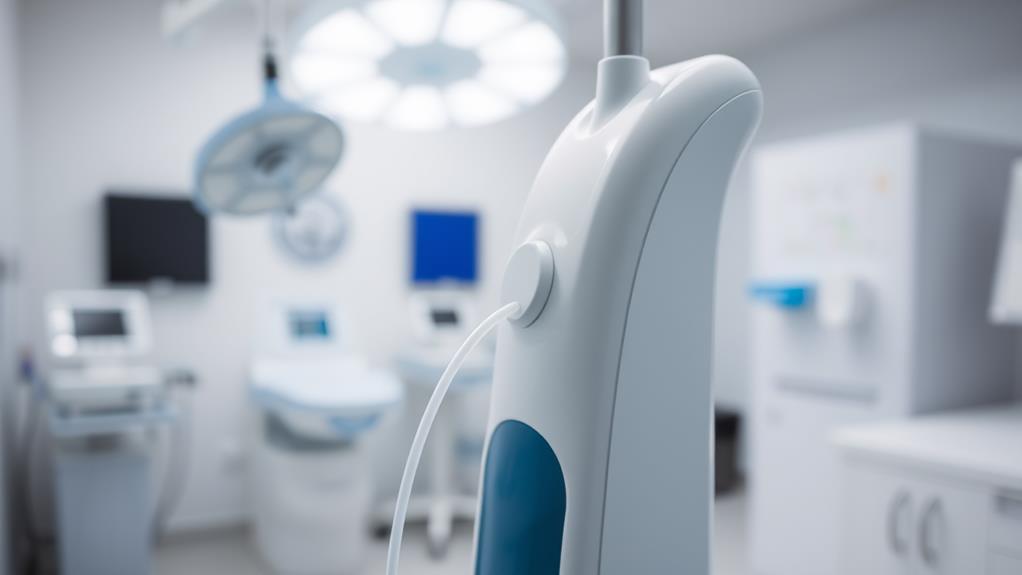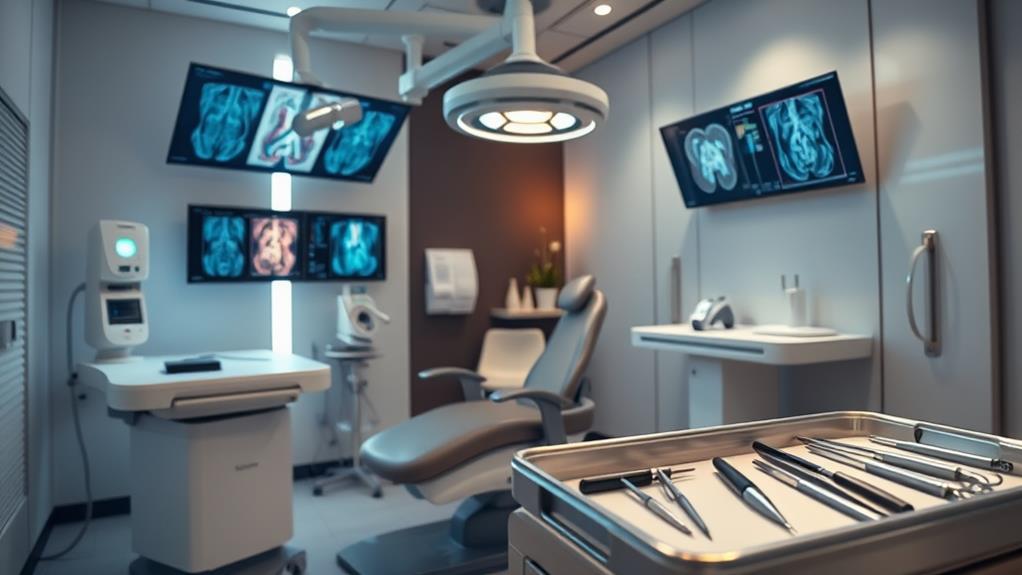As an Amazon Associate I earn from qualifying purchases.
You'll find several innovative office-based procedures for hemorrhoid treatment in 2024. These include radiofrequency ablation, cryotherapy, endoscopic ultrasound-guided artery ligation, and advanced laser therapy. Each offers high success rates with minimal discomfort and quick recovery times. Improved rubber band ligation techniques and new sclerotherapy methods provide additional options. These treatments can effectively manage grade I to III hemorrhoids without requiring traditional surgery. Many procedures take less than an hour and allow you to return to normal activities within days. If you're seeking relief from hemorrhoid symptoms, you'll want to explore these cutting-edge options further.
Radiofrequency Ablation for Hemorrhoids

Radiofrequency ablation's rise as a minimally invasive hemorrhoid treatment has revolutionized office-based procedures. This innovative technique uses heat energy to shrink hemorrhoidal tissue, offering significant symptomatic improvement and enhanced quality of life for patients. You'll find that RFA is typically performed under local anesthesia, taking just 30-60 minutes to complete.
The success rate of radiofrequency ablation is impressive, with up to 90% of patients experiencing substantial symptom relief and reduced post-procedural bleeding after a single treatment. It's a safe and well-tolerated option, carrying minimal risk of complications. Long-term studies have shown sustained efficacy, with 80% of patients remaining symptom-free at 12-month follow-up.
During the procedure, a specialized device delivers heat energy to the hemorrhoidal tissue, causing it to shrink and eventually fall off. RFA is particularly effective for grade I and II hemorrhoids, with success rates reaching 80% in some studies. It's often combined with other office-based treatments like rubber band ligation or sclerotherapy for ideal results. You'll appreciate the quick recovery and minimal discomfort associated with this minimally invasive approach.
Cryotherapy in Hemorrhoid Management
You'll find cryotherapy to be a cutting-edge option for hemorrhoid treatment that uses extreme cold to destroy affected tissue. This minimally invasive procedure offers advantages like reduced pain, lower complication risks, and quick recovery times compared to traditional surgical methods. It's particularly suitable for patients with grade I and II internal hemorrhoids who haven't responded well to conservative treatments or aren't candidates for more invasive procedures.
Mechanism of Cryotherapy Action
The mechanism of cryotherapy action in hemorrhoid treatment involves the application of extreme cold to destroy problematic tissue. This office-based procedure uses a cryoprobe to freeze hemorrhoidal tissue to temperatures between -20°C and -30°C. The freezing process causes the formation of ice crystals within cells, leading to their destruction and eventual necrosis.
Cryotherapy's effectiveness in treating both internal and external hemorrhoids stems from its ability to:
- Cause vascular thrombosis, resulting in ischemia and tissue death
- Trigger cellular destruction through ice crystal formation
- Induce sloughing off of affected tissue over time
The treatment typically involves multiple freeze-thaw cycles, which enhance the tissue destruction process. As the hemorrhoidal tissue dies and sloughs off, you'll experience a reduction in symptoms such as bleeding and prolapse. This mechanism is similar to rubber band ligation but uses cold instead of constriction to achieve the desired effect.
Cryotherapy's versatility makes it a valuable option for patients who may not be suitable candidates for other treatments due to medical conditions or anatomical considerations. While generally safe and well-tolerated, you may experience some discomfort, bleeding, or discharge during recovery.
Advantages Over Other Techniques
Cryotherapy's icy touch offers several advantages over other hemorrhoid treatment techniques. As an office-based procedure, it provides a minimally invasive and low-risk option for treating grade I and II hemorrhoids. You'll find that cryotherapy is relatively painless compared to other methods like rubber band ligation, allowing for a more comfortable experience during and after treatment.
One of the most significant benefits of cryotherapy is its lower recurrence rate. While sclerotherapy has a recurrence rate of 30-50%, cryotherapy boasts a much lower 10-20% rate. This means you're less likely to need repeat treatments in the future. The procedure is also quick, typically taking only 10-15 minutes, making it convenient for those with busy schedules.
Cryotherapy's precise targeting of hemorrhoidal tissue reduces the risk of complications and promotes faster healing. With a success rate of 70-80% in resolving symptoms, it's an effective treatment option for many patients. The non-invasive nature of cryotherapy also means you can return to normal activities immediately after the procedure, minimizing disruption to your daily life.
Patient Selection Criteria
Selecting the right patients for cryotherapy is essential to guarantee prime outcomes in hemorrhoid management. You're an ideal candidate if you have symptomatic internal hemorrhoids that are refractory to conservative treatment. Cryotherapy works best for grade I and II hemorrhoids, particularly when bleeding or pain are your primary symptoms. This minimally invasive procedure is most effective for patients with small, internal hemorrhoids and minimal prolapse.
When considering cryotherapy, your doctor will assess:
- Your hemorrhoidal disease grade
- The presence of other anal pathologies
- Your overall health status
Contraindications for cryotherapy include external or thrombosed hemorrhoids, anal fissures, and rectal bleeding of unknown origin. You're not a suitable candidate if you have severe hemorrhoidal prolapse, anal canal stenosis, or have failed previous office-based treatments. Additionally, if you have bleeding disorders or are immunocompromised, cryotherapy may not be recommended.
Patient selection criteria are pivotal for achieving the best results. By carefully evaluating your specific condition and medical history, your doctor can determine if cryotherapy is the right choice for managing your hemorrhoidal disease effectively and safely.
Endoscopic Ultrasound-Guided Artery Ligation

Endoscopic ultrasound-guided artery ligation (EU-GAL) represents a cutting-edge, minimally invasive approach to treating hemorrhoids. This office-based procedure uses real-time ultrasound guidance to precisely identify and ligate hemorrhoidal arteries, reducing blood flow to the affected area. EU-GAL has shown impressive results in treating grade II and III hemorrhoids, with success rates of up to 90% and a recurrence rate of only 10% at 12 months.
You'll find that EU-GAL offers several advantages over traditional hemorrhoidectomy. The procedure is typically performed under local anesthesia or conscious sedation, taking just 30-60 minutes to complete. You'll experience minimal post-procedure pain and can quickly return to your normal activities. EU-GAL boasts a lower complication rate of 5% compared to the 20-30% associated with hemorrhoidectomy.
Although EU-GAL is a relatively new technique, with initial studies published in 2019, it's already proving to be a safe and effective alternative to surgical treatments. As an office-based procedure, it provides a less invasive option for those seeking hemorrhoid treatment. However, further research is needed to fully understand its long-term efficacy and potential benefits.
Laser Therapy for Hemorrhoid Treatment
You'll find that laser therapy for hemorrhoids has advanced substantially, offering a highly effective treatment option. When compared to other procedures, laser therapy boasts impressive success rates of 80-90% with low recurrence. You'll appreciate the quick recovery time and minimal discomfort, allowing you to return to your daily activities soon after the procedure.
Laser Technology Advancements
In light of recent advancements, laser technology has emerged as a promising option for hemorrhoid treatment. Laser hemorrhoidectomy, a minimally invasive procedure, uses a diode laser to coagulate and shrink hemorrhoidal tissue. This innovative approach offers several advantages over traditional surgical treatments:
- Reduced postoperative pain and faster recovery times
- Higher success rates, with studies reporting up to 92.5% effectiveness
- Lower risk of complications, such as bleeding and infection
You'll find that laser therapy can be used for both internal and external hemorrhoids, including grade II and III hemorrhoids. The procedure can be performed under local anesthesia in an office-based setting, making it more convenient and accessible for patients.
One of the key benefits of laser technology is its versatility. It can be combined with other office-based treatments like rubber band ligation to provide an exhaustive approach to hemorrhoid management. This flexibility allows your healthcare provider to tailor the treatment to your specific needs, potentially improving overall outcomes.
As laser technology continues to advance, you can expect even more refined and effective treatments for hemorrhoids in the future, further enhancing patient comfort and success rates.
Procedure Efficacy Comparison
Laser therapy's efficacy in treating hemorrhoids stands out when compared to other office-based procedures. A systematic review and meta-analysis of 11 studies revealed that laser therapy has a substantially higher success rate (85.7%) compared to rubber band ligation (73.2%) and sclerotherapy (64.5%).
You'll find that laser therapy offers several advantages in hemorrhoid treatment. It boasts lower recurrence rates (12.5%) compared to rubber band ligation (24.5%) and sclerotherapy (31.3%). Additionally, you'll experience faster recovery times, with patients returning to normal activities in just 3.2 days after laser therapy, compared to 5.6 days for sclerotherapy and 7.1 days for rubber band ligation.
Postoperative pain is also reduced with laser therapy, with patients reporting lower pain scores compared to other procedures. Complications are less frequent, occurring in only 5% of cases, compared to 12.5% for rubber band ligation and 15% for sclerotherapy. For grade II hemorrhoids, laser therapy achieves a remarkable 92.5% success rate, markedly improving symptoms and quality of life. These findings from randomized controlled trials demonstrate that laser therapy offers superior efficacy and patient satisfaction in office-based hemorrhoid treatment.
Patient Recovery Benefits
When it comes to patient recovery, how does laser therapy for hemorrhoid treatment stack up? You'll be pleased to know that this innovative approach offers significant benefits over traditional hemorrhoidectomy. Laser therapy results in less postoperative pain, allowing you to recover more comfortably with minimal analgesic use. You'll experience faster recovery times, often returning to normal activities within 24-48 hours, compared to 7-10 days for surgical interventions.
Laser therapy for hemorrhoids provides several advantages:
- Reduced bleeding and hematoma formation (2% vs. 10% for traditional methods)
- Shorter hospital stays (1.3 days vs. 2.5 days)
- Lower risk of complications like urinary retention and anal stenosis
You'll appreciate the minimally invasive nature of laser treatment, which leads to less post-procedure pain and a cleaner recovery process with minimal bleeding and discharge. The precise targeting of hemorrhoidal tissue minimizes the risk of complications such as anal stricture or incontinence. Studies show that 90% of patients report significant improvement in symptoms within two weeks, with 75% experiencing complete resolution within six weeks. Overall, laser therapy offers a more comfortable and efficient recovery experience compared to traditional hemorrhoidectomy.
Advances in Rubber Band Ligation

Rubber band ligation has long been a go-to treatment for internal hemorrhoids, but recent advances have made this procedure even more effective and patient-friendly. The American Society of Colon and Rectal Surgeons (ASCRS) strongly recommends this technique for grade I-II hemorrhoids, with success rates ranging from 70% to 90%.
Recent innovations have improved the procedure's efficacy and patient comfort:
| Advancement | Benefit | Consideration |
|---|---|---|
| Endoscopic suction ligator | Improved precision | Higher cost |
| Single-handed device | Easier application | Learning curve |
| Wall suction ligator | Better for certain patients | Limited availability |
| Modified technique | Reduced pain | Varied success rates |
You'll find that these new approaches can substantially reduce pain and bleeding risks. Some clinicians now use smaller rubber bands or suction devices to minimize discomfort. Topical anesthetics and oral pain medications can further improve your experience.
While rubber band ligation isn't suitable for everyone, especially those with coagulation issues or cirrhosis, it's generally safe with a low complication rate of 5-10%. If you're considering treatment for internal hemorrhoids, discuss these advanced options with your doctor to determine the best approach for your specific case.
Sclerotherapy Techniques and Innovations
In light of recent advancements, sclerotherapy has emerged as a highly effective office-based treatment for hemorrhoids. This technique involves injecting a sclerosing agent into the hemorrhoidal tissue, causing an inflammatory reaction that leads to scarring and shrinkage of hemorrhoidal cushions. You'll find sclerotherapy particularly effective for grade II and grade III internal hemorrhoids, with success rates ranging from 75% to 90%.
Several innovative sclerotherapy techniques have been developed, including:
- ALTA sclerotherapy: Widely used in Japan with high success rates for grade II and III hemorrhoids
- PAO sclerotherapy: Effective for internal hemorrhoids up to grade III, boasting a 90.7% overall success rate
- Foam sclerotherapy: Allows for more efficient distribution of the sclerosing agent
The most commonly used sclerosing agents include phenol, quinine, and almond oil. You'll typically undergo a series of 2-3 injections at 2-4 week intervals. Sclerotherapy's success rate varies depending on hemorrhoid severity, with 70-80% effectiveness for grade I and II hemorrhoids. When combined with other office-based treatments, you can expect ideal results in managing your hemorrhoid symptoms.
Minimally Invasive Surgical Options

Minimally invasive surgical options have gained traction in recent years for treating hemorrhoids. These procedures offer effective solutions with faster recovery times and reduced complications compared to traditional hemorrhoidectomy.
For internal hemorrhoids of grade II or III, you'll find several options available:
| Procedure | Success Rate | Key Feature |
|---|---|---|
| Doppler-guided HAL | 80-90% | Precise artery ligation |
| Stapled hemorrhoidopexy | 70-80% | Repositions tissue |
| THD | 80-90% | Combines ligation and tissue removal |
| HAL-RAR | 80-90% | Addresses mucosal prolapse |
Rubber band ligation is strongly recommended for grade I and II hemorrhoids, while infrared coagulation and sclerotherapy are effective alternatives. These office-based procedures can be performed without general anesthesia, making them convenient for patients.
Laser hemorrhoidectomy, with a 70-80% success rate, offers another minimally invasive option. It uses targeted laser energy to remove excess tissue.
When considering treatment, discuss these options with your healthcare provider. They'll help you choose the most appropriate procedure based on your specific condition, taking into account factors such as hemorrhoid grade, symptoms, and overall health.
Combination Therapies for Optimal Results
Synergy in hemorrhoid treatment often yields superior outcomes. You'll find that combining rubber band ligation (RBL) with other techniques can notably improve your results. For instance, RBL paired with sclerotherapy boasts a 93.1% success rate, reducing recurrence rates for grade III hemorrhoids. Similarly, RBL combined with infrared coagulation achieves a 95% success rate with minimal complications.
When considering combination therapies for hemorrhoid treatment, you have several effective options:
- RBL with sclerotherapy using polidocanol
- RBL and infrared photocoagulation
- RBL combined with Doppler-guided hemorrhoidal artery ligation
These approaches not only enhance treatment efficacy but also reduce post-procedure pain. A study of 500 patients found that combining RBL and sclerotherapy resulted in a mean pain score of just 2.1 out of 10. For high-grade internal hemorrhoids or recurrent cases, combination therapies can provide more effective symptom relief and minimize the need for surgical interventions. Additionally, incorporating phlebotonics or flavonoids with office-based treatments can further improve outcomes, reducing bleeding, pruritus, and recurrences. By leveraging these synergistic approaches, you can optimize your hemorrhoid treatment strategy for better long-term results.
Frequently Asked Questions
What Are the Newest Procedures for Hemorrhoids?
You'll find new techniques for hemorrhoids like advanced laser therapy and improved hemorrhoid banding. These minimally invasive, outpatient procedures offer quick fixes with fast recovery. Non-surgical methods and pain relief options are evolving, providing more effective treatments.
What Are the Latest Advances in the Management of Hemorrhoids?
You'll find recent advances in hemorrhoid management focus on better patient education, refined classification systems, and improved pain management. There's a greater emphasis on lifestyle modifications for prevention and a wider range of treatment options for symptom relief.
What Is the Office Based Treatment for Hemorrhoids?
You can find relief from hemorrhoid symptoms with fast, effective solutions. Office visits offer non-surgical options like rubber band ligation, sclerotherapy, and infrared coagulation. These in-office procedures provide quick recovery with minor discomfort and fast healing.
What Is the Most Effective Procedure for Hemorrhoids?
Rubber band ligation is your most effective hemorrhoid treatment. It manages pain and symptoms with minimal risks. You'll experience shorter recovery time and lower costs compared to surgery. Guarantee your doctor's qualified and check insurance coverage beforehand.
Conclusion
You're on the cusp of a revolution in hemorrhoid care. These cutting-edge treatments are like beacons of hope, illuminating a path away from discomfort. As you explore these options, you'll find they're not just procedures, but gateways to a life unburdened by pain. Embrace the future of hemorrhoid management—it's knocking at your door, offering a world where relief isn't just possible, it's within arm's reach. Don't let this opportunity slip through your fingers.
Amazon and the Amazon logo are trademarks of Amazon.com, Inc, or its affiliates.
